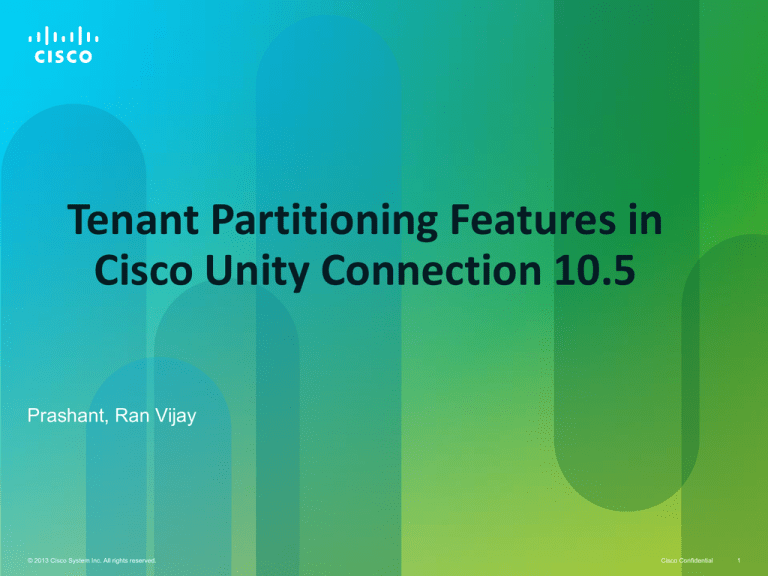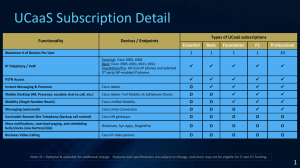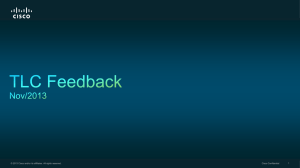
Tenant Partitioning Features in
Cisco Unity Connection 10.5
Prashant, Ran Vijay
© 2013 Cisco System Inc. All rights reserved.
reserved
Cisco Confidential
1
• Support for Shared Ports Model in Tenant Partitioned Cisco Unity Connection server
• Topologies
• Scenarios
• Unified Messaging (Office 365) support in Tenant Partitioned Cisco Unity Connection
server
• Provisioning Unified Messaging using External Service API
• Thread Group Allocation & Scheduling in Tenant Partitioning for Office 365
• Scenarios
• Tenant Active Directory Integration with Partitioned Cisco Unity Connection Server
•
Bulk License User Support in Cisco Unity Connection server
• Overview
• Scenarios
© 2013 Cisco System Inc. All rights reserved
Cisco Confidential
2
.© 2013 Cisco System Inc. All rights reserved
Cisco Confidential
3
Shared ports model has been introduced in Tenant Partitioned Unity Connection server in
Release 10.5:
• PhoneSystem will be shared among the tenants.
• Routing rule conditions will be based on Dialed number that will be a Pilot Number for
a particular Tenant..
• Number of ports configured under the PhoneSystem will be shared among the Tenants.
Highlights about Tenant Creation:
Tenant can be created in Shared ports model with Parameters: Tenant Alias, SMTP
domain, Pilot Number, and Media Switch
• Tenant will have Unique Pilot Number
• Tenant will have Shared Phone System.
• Routing Rule conditions will be created based on Pilot Number (as dialed number
condition)
© 2013 Cisco System Inc. All rights reserved
Cisco Confidential
4
• Only Tenants with Dedicated Phone System.
• Only Tenants with Shared Phone System.
• Combination of Tenants where few are using Shared Phone System and few are using
Dedicated Shone system.
© 2013 Cisco System Inc. All rights reserved
Cisco Confidential
5
© 2013 Cisco System Inc. All rights reserved
Cisco Confidential
6
© 2013 Cisco System Inc. All rights reserved
Cisco Confidential
7
© 2013 Cisco System Inc. All rights reserved
Cisco Confidential
8
CUCM
Settings
Create SIP
Security
Profile
Create SIP
Profile
Create SIP
Trunk
Create
Route
Pattern and
associate
with Trunk
Create
Voice Mail
Pilot and
Voice Mail
Profile
Call
Pilot
Number
CUC
Settings
© 2013 Cisco System Inc. All rights reserved
Create Tenant
with pilot
number as
specified in
CUCM
Create Required
Port Group/Ports
Record
Greetings
Configure User
for the tenant
Cisco Confidential
9
To create a tenant, an HTTP POST request should be sent to the URI
https://<connection-server>/vmrest/tenants
The request should contain values for the following fields:
1.
Alias: Represents the alias of the tenant.
2.
SMTPDomain: Represents the corporate SMTP Domain of the tenant.
3.
Pilot Number : Represents the unique number on which tenant can be accessed.
4.
MediaSwitchObjectId : Represents object Id of the Phonesytem to which this tenant
is to be associated.
5.
To fetch the ‘MediaSwitchObjectId’ perform GET operation on API
URI GET: :https://<connection_server>/vmrest/phonesystems
© 2013 Cisco System Inc. All rights reserved
Cisco Confidential
10
To create a tenant with alias “Texoma”, an HTTP POST request should be sent to the URI
https://ucbu-aricent-vm435.cisco.com/vmrest/tenants
With following request body:
<Tenant>
<Alias>Texoma</Alias>
<Description>Tenant for Texoma Inc</Description>
<SmtpDomain>Texoma.com</SmtpDomain>
<PilotNumber>1290</PilotNumber>
<MediaSwitchObjectId>9886f764-ef4e-41c3-bd47977aed91ebc4</MediaSwitchObjectId>
</Tenant>
© 2013 Cisco System Inc. All rights reserved
Cisco Confidential
11
• Fgsgssgsdgs
• Above snapshot shows Tenant “Texoma” is created having 1290 as
dialed Number in Routing rules.
© 2013 Cisco System Inc. All rights reserved
Cisco Confidential
12
.© 2013 Cisco System Inc. All rights reserved
Cisco Confidential
13
Unified Messaging Service REST API has been introduced to create, list, modify, delete,
and reset Unified Messaging Services (also known as external services). Each Unified
Messaging Service Accounts created for a user is based on a Unified Messaging Service.
Unified Messaging Service for Tenant will be based on the Office 365.
© 2013 Cisco System Inc. All rights reserved
Cisco Confidential
14
The pre-conditions are:
•
Tenant should have Microsoft License for Office 365 , to use Office 365
services.
•
Each Tenant should have it’s own unique Unified Messaging Service. If there
are N-tenants configured on Unity Connection, then there should be N
different Unified services.
© 2013 Cisco System Inc. All rights reserved
Cisco Confidential
15
To create a Unified Messaging Service , an HTTP POST request should be sent to the URI
https://<connection-server>/vmrest/externalservices
The request must contain values for the following fields:
1.
DisplayName: A descriptive name for the Unified Messaging Service.
2.
ServiceAlias : Represents the Active Directory username of the unified messaging
services account in the format : user@domain
3.
ServicePassword: The password for the Active Directory account that you entered in
the ServiceAlias field.
4.
ServerType: The type of Unified Messaging Service ,its value is 5 for Office 365.
5.
ExchDoAutodiscover: Flag indicating whether Unity Connection is permitted to
search the network for the URL, to log in to Office365. Unity Connection may use the
Exchange Autodiscovery feature in combination with LDAP and DNS calls to identify
the EWS URL.
6.
ExchOrgDomain:Represents root of the domain to search for autodiscovery.
© 2013 Cisco System Inc. All rights reserved
Cisco Confidential
16
To associate Unified Messaging Service with user, an HTTP POST request should be sent to
the URI
https://<connection-server>/vmrest/users/<User-objectid>/externalserviceaccounts
The request should contain values for the following fields:
1.
ExternalServiceObjectId: The unique identifier of the Unified Messaging Service
object will be associated with the user.
2.
EmailAddress: The user's primary SMTP address already existing on Office 365.
© 2013 Cisco System Inc. All rights reserved
Cisco Confidential
17
To Reset Unified Messaging Service
• Perform GET operation Unified Messaging Service API.
GET: :https://<connection_server>/vmrest/externalservices
• Fetch the object Id of service from response.
• Perform reset operation on above fetched service
PUT: :https://<connection_server>/vmrest/externalservices/<object-id>/reset
© 2013 Cisco System Inc. All rights reserved
Cisco Confidential
18
.© 2013 Cisco System Inc. All rights reserved
Cisco Confidential
19
• Presently Cisco unity connection provides support for 20 LDAP integration and
authorization .But In case of Tenant partitioned unity connection where each tenant
can have unique LDAP , integration of LDAP with unity connection would not be
possible due to restriction of LDAP integration supported by connection.
• To overcome this issue , Active Directory Application Mode can be used with unity
connection to provide directory services in Tenant partitioned unity connection .In this
case Tenant partitioned cisco unity connection will synchronize with ADAM server for
user import and authentication and ADAM server will sync with Tenant’s LDAP for
authentication
• Active Directory Lightweight Directory Service (AD LDS), formerly known as Active
Directory Application Mode, can be used to provide directory services for directoryenabled applications.
• AD LDS can be used in conjunction with AD DS so that multiple tenants can have a
central location for security accounts (AD DS) and another location to support the
application configuration and directory data (AD LDS).
© 2013 Cisco System Inc. All rights reserved
Cisco Confidential
20
© 2013 Cisco System Inc. All rights reserved
Cisco Confidential
21
• For the purpose of explaining the AD LDS support, we imagine a scenario where large
Enterprise A (Cisco Systems) is hosting multi-tenancy solution for two or more tenants
(SMB enterprises)). Enterprise B and C will act as Tenants supported by the Enterprise
A. The user directory of enterprise B and C can be imported into the AD LDS server
running under Enterprise A.
• Enterprise A has a single domain (Multi-tenant supported unity connection) that has
Domain Controller that is also a Global Catalogue, and it is hosted in a Windows 2008
Server with SP2, or equivalent Windows server running AD LDS.
• Enterprise Tandberg (Tenant 1), say, has a single domain that has Domain Controller
that is also a Global Catalogue, and it is hosted in a Windows 2008 Server with SP2.
© 2013 Cisco System Inc. All rights reserved
Cisco Confidential
22
• Enterprise WebEx (Tenant 2), say, has a single domain that has a Domain Controller.
This Domain Controller is also a Global Catalog and is hosted in a Windows Server .
• Install the AD LDS in the DC of the enterprise hosting the multi-tenant solution. Other
enterprises that are acting as tenants will need to setup inter-domain trust relationship
between their DC/GC and the AD LDS for authentication.
• Note : For Detailed information ,Please visit the following link
https://supportforums.cisco.com/docs/DOC-16356
http://www.cisco.com/en/US/products/sw/voicesw/ps556/products_configuration_exam
ple09186a0080b2b103.shtml
© 2013 Cisco System Inc. All rights reserved
Cisco Confidential
23
• To import the users from LDAP using REST API, Please follow the below steps
Step 1: Fetch the list of users from LDAP
REST Operation: GET URI : http://<server>/vmrest/import/users/ldap
Step 2: Import the list of users (Response of step-1) in Unity Connection
REST Operation: POST URI
:http://<server>/vmrest/import/users/ldap?templateAlias=<voicemailusertemplate of the
tenant under which the user is to be imported>
Note : For detailed information, please visit the following link :
• http://docwikidev.cisco.com/wiki/Cisco_Unity_Connection_Provisioning_Interface_(C
UPI)_API_--_User_Import
© 2013 Cisco System Inc. All rights reserved
Cisco Confidential
24
.© 2013 Cisco System Inc. All rights reserved
Cisco Confidential
25
Bulk License User Support API has been introduced to fetch all the users along with
the license detail of each user. The API response will contain users which are using any
kind of license.
Main Features:
• Fetch all the users using any kind of license in the unity connection.
• Works for both Multi Tenant Mode and Non Multi Tenant Mode.
• rowsPerPage and pageNumber query parameters can be used to fetch users based on
pagination.
• Query parameters can be used to fetch license used by one user.
© 2013 Cisco System Inc. All rights reserved
Cisco Confidential
26
Fetch User Licenses using the paginations
To fetch user licenses using the pagination , an HTTPs GET request should be sent to the
URI
URI : https://<connection-server>/vmrest/userlicenses?rowsPerPage=1&pageNumber=1
Fetch count of users using any kind of license
Total Number of users using any kind of licenses can be fetched by setting the
pageNumber field to 0.
URI : https://<connection-server/vmrest/userlicenses?pageNumber=0
Fetch all Users using only one kind of license
Query parameter can be used to fetch the total number of users using only one kind of
license:
URI : https://<connection-server/vmrest/userlicense?query=(Messaging is
CUC_BasicMessaging
For further query following document can be referred:
http://wikicentral.cisco.com/display/UNITYTRANS/Bulk+User+License+API+Docwiki+Refere
nce
© 2013 Cisco System Inc. All rights reserved
Cisco Confidential
27
.© 2013 Cisco System Inc. All rights reserved
Cisco Confidential
28
• For issues in Office 365 please refer the following documents.
http://wikicentral.cisco.com/display/UNITYTRANS/Diagnostic+Traces+for+Unified+Messag
ing%28Office+365+%29+support+in+Tenant+Partitioned+Cisco+Unity+Connection
http://www.cisco.com/c/en/us/td/docs/voice_ip_comm/connection/10x/troubleshooting
/guide/10xcuctsgx/10xcuctsg039.html
• For issues in AD LDS support in Tenant Partitioned Cisco Unity Connection refer the
following documents
https://supportforums.cisco.com/docs/DOC-16356
http://www.cisco.com/en/US/products/sw/voicesw/ps556/products_configuration_exam
ple09186a0080b2b103.shtml
© 2013 Cisco System Inc. All rights reserved
Cisco Confidential
29
.© 2013 Cisco System Inc. All rights reserved
Cisco Confidential
30








